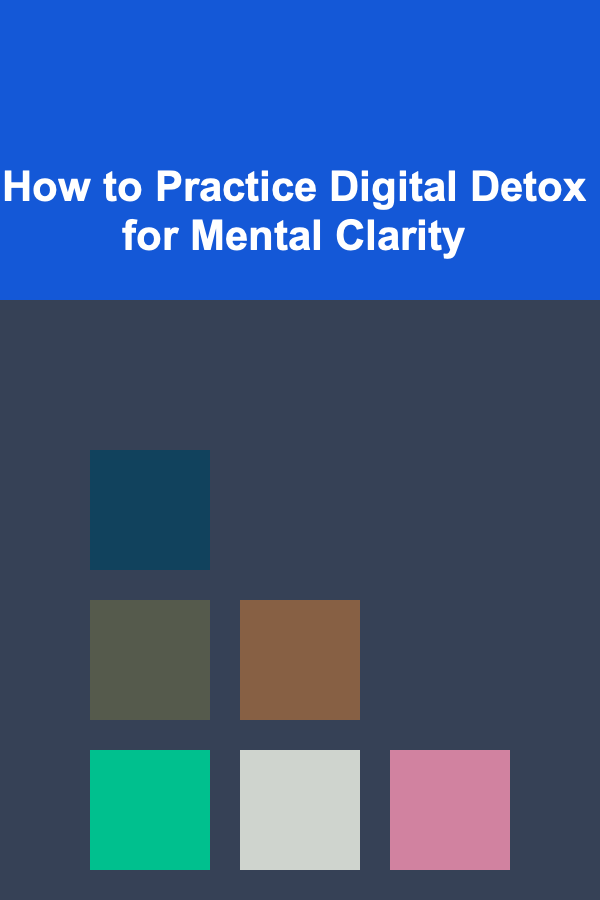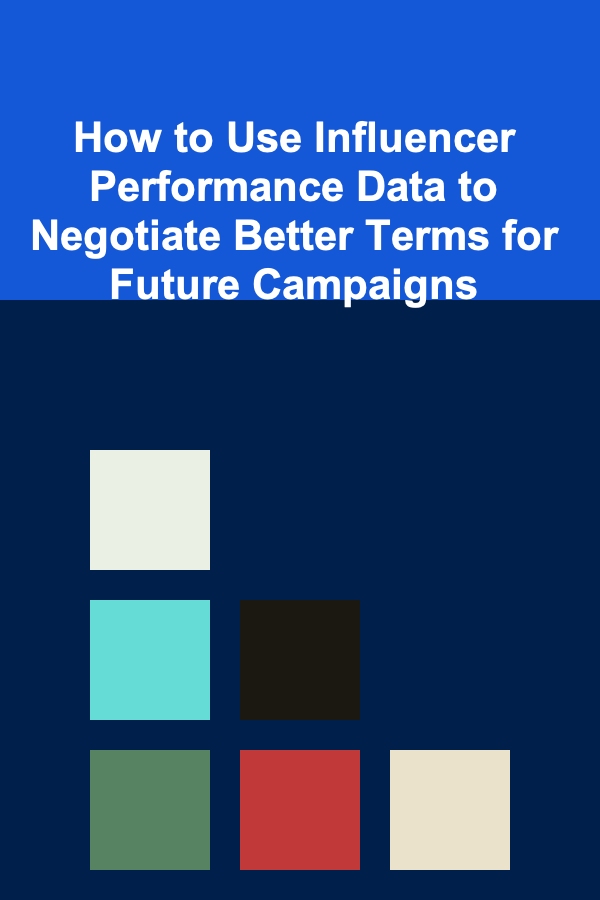
How to Practice Digital Detox for Mental Clarity
ebook include PDF & Audio bundle (Micro Guide)
$12.99$9.99
Limited Time Offer! Order within the next:

In today's fast-paced digital world, it is nearly impossible to go through a single day without interacting with some form of technology. From social media platforms to work emails, news updates, and even entertainment, the digital landscape has become deeply ingrained in our daily lives. While this constant connectivity offers convenience and access to information, it can also lead to digital overload, which has significant implications for our mental clarity, emotional health, and overall well-being. Digital detox, the practice of taking breaks from digital devices, has emerged as an effective solution to combat this overwhelming digital culture and reclaim a sense of balance.
This article explores the concept of digital detox, its impact on mental clarity, and practical strategies for integrating digital detox into your life.
The Impact of Constant Connectivity
1. The Overload of Information
With the rise of the internet, social media, and constant access to news, we are constantly bombarded with information. While access to this information can be valuable, it can also overwhelm us. The human brain is not designed to process such vast quantities of data at once, leading to mental fatigue. This information overload can diminish our ability to focus on meaningful tasks and impair our decision-making abilities.
2. Decreased Attention Span
The constant stream of notifications, messages, and updates on our smartphones and computers has significantly reduced our attention span. Studies have shown that the average attention span of humans has decreased in recent years, primarily due to the addictive nature of digital devices. People are constantly shifting their focus between different tasks and platforms, preventing deep, sustained concentration on any one thing. This fragmented attention has a direct impact on productivity, creativity, and mental clarity.
3. Increased Anxiety and Stress
Digital devices, particularly social media, can often be a source of stress and anxiety. The constant comparison to others, the pressure to maintain an idealized online persona, and the fear of missing out (FOMO) are all stressors associated with social media use. Constant notifications and the feeling of needing to stay connected at all times can increase anxiety, disrupt sleep, and cause a sense of overwhelm.
4. Disrupted Sleep Patterns
The blue light emitted by digital screens interferes with the production of melatonin, the hormone responsible for regulating sleep. Spending long hours on devices late into the night can make it difficult to fall asleep and result in poor-quality sleep. The lack of restful sleep over time can contribute to cognitive decline, reduced mental clarity, and even mood disorders such as depression and anxiety.
5. Negative Impact on Relationships
Constant digital connectivity can also take a toll on personal relationships. People may be more focused on their devices than on engaging with the people around them. This lack of presence can create feelings of isolation, misunderstandings, and emotional distance in relationships, whether with family members, friends, or romantic partners.
The Benefits of a Digital Detox
Engaging in a digital detox, or taking regular breaks from technology, offers numerous benefits for mental clarity and overall well-being. Here are some of the key advantages:
1. Improved Focus and Concentration
When you disconnect from your devices, you create space for uninterrupted, deep focus. Without the constant distractions of notifications, emails, and social media, you can engage in tasks more fully and with greater mental clarity. This increased focus can enhance productivity, creativity, and problem-solving abilities.
2. Reduced Stress and Anxiety
Taking a break from the digital world can significantly reduce the stress and anxiety that often accompany constant connectivity. Without the pressure to respond immediately to messages, emails, or social media notifications, you give yourself the opportunity to relax, recharge, and regain emotional balance. Digital detox allows you to step away from the information overload and focus on what truly matters in the present moment.
3. Better Sleep
Disconnecting from screens before bedtime improves sleep quality. With fewer distractions and the reduction of blue light exposure, your body can naturally prepare for restful sleep. Better sleep leads to improved cognitive function, better mood regulation, and an overall sense of mental clarity the following day.
4. Increased Mindfulness
A digital detox promotes mindfulness by allowing you to be fully present in the moment. Whether you're spending time with family and friends, engaging in a hobby, or simply relaxing, taking a break from technology allows you to reconnect with your surroundings and yourself. This mindfulness enhances emotional awareness, reduces stress, and improves overall well-being.
5. Improved Relationships
By reducing your screen time, you create more opportunities for meaningful face-to-face interactions with others. Engaging in conversations and activities without the distraction of digital devices fosters stronger connections with loved ones and helps cultivate deeper, more fulfilling relationships.
How to Practice a Digital Detox for Mental Clarity
1. Set Clear Goals for Your Detox
Before embarking on a digital detox, it's essential to set clear intentions. Ask yourself why you're taking a break from technology. Are you looking to reduce stress, improve focus, or reclaim time for personal hobbies and relationships? Understanding your goals will help you stay motivated and committed to your detox.
2. Determine the Duration of Your Detox
Digital detox can be practiced in various ways, depending on your needs and lifestyle. You can choose to take a short break---such as a few hours during the day---or go for a longer period, like a weekend or even a week. It's important to start with a manageable duration to avoid feeling overwhelmed. As you become more comfortable, you can extend the detox duration.
- Short-Term Detox: This could involve taking an afternoon or evening off from screens. Use this time to engage in non-digital activities, such as reading, exercising, or spending time with loved ones.
- Weekend Detox: Take an entire weekend off from digital devices. This is a great way to reset and recharge, giving yourself space to disconnect from work and social media.
- Long-Term Detox: For those seeking a more profound reset, you may want to try a week-long detox, which allows for a more significant mental and emotional shift.
3. Identify and Minimize Your Digital Habits
Identify which digital devices and activities contribute most to your stress and mental overload. These might include:
- Social media platforms: Spend a lot of time scrolling through Facebook, Instagram, or Twitter?
- Email: Constantly checking work or personal emails, leading to stress and distractions?
- News websites: Do you feel overwhelmed by the constant stream of news updates?
Once you identify these habits, take steps to minimize or eliminate them during your detox period. You may want to delete certain apps from your phone, set up email filters, or use website-blocking apps to reduce your screen time.
4. Set Boundaries Around Technology Use
A digital detox doesn't mean cutting off all technology entirely---it's about setting boundaries. Establish clear rules around when and how you will use digital devices. Some strategies to help set boundaries include:
- Designated no-screen times: Establish specific times during the day when you won't check your phone or other devices, such as during meals or an hour before bed.
- Technology-free zones: Create areas in your home, such as the bedroom or dining room, where digital devices are off-limits to encourage more meaningful interactions and relaxation.
- Turning off notifications: Disable notifications for social media, emails, and other apps so you are not constantly interrupted.
5. Engage in Offline Activities
To make your digital detox more rewarding, engage in offline activities that promote mental clarity and relaxation. Some activities to consider include:
- Exercise: Physical activity is a powerful stress reliever that improves mental clarity. Whether it's going for a walk, doing yoga, or hitting the gym, exercise will help reset your mind.
- Journaling: Take time to reflect on your thoughts and emotions by writing in a journal. Journaling can help you gain clarity, reduce stress, and improve your emotional well-being.
- Creative hobbies: Engage in creative activities such as painting, drawing, writing, or playing an instrument. These activities stimulate the brain in a different way than digital devices and can help you tap into your creativity.
- Spending time in nature: Nature has a calming effect on the mind. Take walks in the park, hike, or simply sit in a garden to reconnect with the natural world.
6. Practice Mindfulness
Mindfulness is the practice of being fully present in the moment. It involves focusing on your thoughts, feelings, and surroundings without distraction. During a digital detox, practice mindfulness by engaging in activities that help you stay present, such as deep breathing exercises, meditation, or mindful eating.
7. Reflect and Reassess
After completing a digital detox, take time to reflect on your experience. How did it feel to disconnect from technology? Did you notice any changes in your mood, energy levels, or mental clarity? Reassess your relationship with technology and determine whether there are any lasting changes you want to make in how you use digital devices.
Conclusion
In an age where digital devices are an integral part of everyday life, it's crucial to take intentional breaks to restore mental clarity and well-being. A digital detox can be a powerful tool to help combat the negative effects of constant connectivity, including stress, anxiety, and information overload. By setting boundaries, engaging in offline activities, and practicing mindfulness, you can reclaim your time, improve your focus, and experience greater mental clarity.
Remember, a digital detox isn't about rejecting technology entirely---it's about finding balance and learning how to use technology in a way that enhances, rather than detracts from, your quality of life. Take the time to unplug, reconnect with yourself and those around you, and discover the positive effects that a digital detox can have on your mental and emotional health.

How to Designate Activity Zones for Different Family Interests
Read More
How to Style Your Bookshelves on a Budget
Read More
How to Use Influencer Performance Data to Negotiate Better Terms for Future Campaigns
Read More
How To Debunk the Flat Earth Model (Comprehensive Guide)
Read More
Understanding Electron Beam Melting (EBM) 3D Printing
Read More
Building a Relationship Full of Laughter and Joy
Read MoreOther Products

How to Designate Activity Zones for Different Family Interests
Read More
How to Style Your Bookshelves on a Budget
Read More
How to Use Influencer Performance Data to Negotiate Better Terms for Future Campaigns
Read More
How To Debunk the Flat Earth Model (Comprehensive Guide)
Read More
Understanding Electron Beam Melting (EBM) 3D Printing
Read More